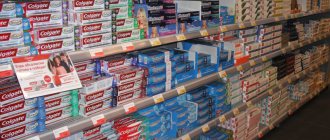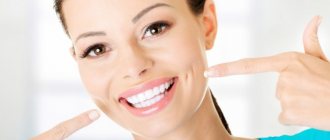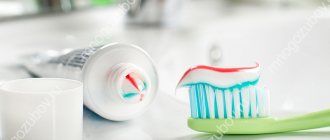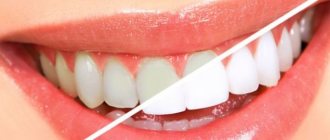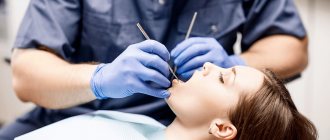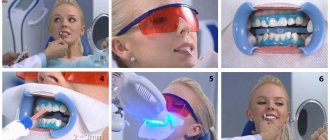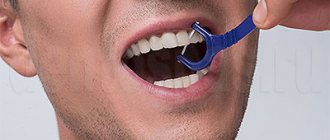One of the simplest, quite effective and at the same time cheap ways to whiten teeth at home is regular soda. However, you should use it no more than once a week.
By the way, soda is used not only to whiten teeth, but also to relieve inflammation of the gums and eliminate bad breath. To soothe the gums, mix soda with water to form a paste, apply to the inflamed areas of the gums and gently massage for several minutes.
To eliminate the unpleasant odor, dilute a teaspoon of soda in a glass (200 ml) of warm water and rinse the mouth.
As for whitening with soda, this procedure is quite simple, but you need to prepare for it.
Contraindication to bleaching with soda
Dentists advise that before starting the whitening procedure with soda, visit the dental office and check the health of your teeth.
Also, this method of whitening, like some other methods, is not recommended for those who:
- have periodontal disease;
- gums bleed;
- ulcers and stomatitis are observed in the oral cavity;
- teeth are overly sensitive;
- tooth enamel is very thin;
- superficial caries is observed or molars are affected;
- There are crowns in front, which will become even more noticeable after the whitening procedure.
For what?
Cleaning with soda is an extremely popular, affordable and effective method that allows you to quickly remove plaque and lighten enamel using soda. This method is low cost and easy to use; everyone can try it out for themselves by spending a small amount of money.
However, this procedure also has a number of disadvantages. Firstly, such cleaning should not be performed more than once a week. The cleansing ability of soda is associated with its abrasive properties: small particles literally scrape off the thinnest outer layer of enamel along with the plaque pigment embedded in it, after which the teeth become lighter and cleaner. However, tooth sensitivity often increases - and this is another disadvantage of brushing with soda.
Teeth whitening at home with soda: methods of application
Dentists do not recommend using pure soda for teeth whitening, which can have a negative effect on the enamel. Therefore, if you decide to use soda to make your teeth white, supplement it with various substances.
- Baking soda and hydrogen peroxide. Prepare a solution of three percent hydrogen peroxide and soda (mix until smooth) and brush your teeth (brush for no longer than 3-4 minutes). Then rinse your mouth and brush your teeth with fluoride paste.
- Soda with lemon juice. Sprinkle a little baking soda on a damp toothbrush (you can use a cotton pad) and add a couple drops of lemon juice. Wipe or brush your teeth with the resulting product, then rinse with water.
- Soda and strawberries. Mash a couple of ripe strawberries and add a pinch of soda to the pulp. Apply the resulting substance to the entire dentition using a soft brush, leave for five to eight minutes and rinse. Rinse your mouth with filtered water (you can use boiled water) and clean your mouth with fluoride paste.
- Soda and iodine. This remedy has proven its effectiveness not only in the fight against plaque, but also against tartar and bacterial diseases of the oral cavity. To prepare a slurry of optimal consistency, you need to take a teaspoon of soda, add a couple of drops of iodine to it and mix with a toothpick or match. For best effect, you can hold the product on your teeth for a couple of minutes. Then rinse and rinse thoroughly, brush your teeth with regular or fluoride-containing toothpaste. Attention: this remedy is not suitable for allergy sufferers or those with endocrine diseases.
- Soda and vinegar. Mix these two substances until a homogeneous paste is obtained. Apply it to your teeth using a cotton pad, brush or fingers, and massage gently for several minutes. Rinse and rinse mouth thoroughly.
- Soda with peroxide and lemon. Take half a teaspoon each of lemon juice and soda, add five drops of peroxide (three percent). Using your finger, apply the product to your teeth and distribute evenly. Try not to get it on your gums. Wait a couple of minutes and rinse off using warm water. Brush your teeth and rinse your mouth well.
- Soda and toothpaste. Add soda to regular toothpaste, mix and brush your teeth as usual.
- Soda and activated carbon. Grind activated carbon, mix with soda (in equal proportions), add two drops of hydrogen peroxide and lemon. Brush your teeth with the resulting mixture, then rinse with warm water several times.
Regardless of the whitening method you choose, remember that using soda frequently is unacceptable. After the procedure, it is not advisable to drink hot and cold drinks (at least for an hour), and give up strong tea, coffee, wine and cigarettes for at least a day in order to maintain the whitening effect. There are other methods of teeth whitening, such as whitening gels.
If these methods seem ineffective to you, try ASEPTA PLUS Gentle Whitening toothpaste. The enzyme papain included in its composition effectively breaks down plaque, and pyrophosphates dissolve the mineral component of deposits on the teeth. Your smile will become snow-white!
Content:
- How to whiten teeth
- Effective dental techniques you can trust
- Unprofessional whitening
- How to whiten teeth - composition of special dental gels
- How to do teeth whitening
- How to extend the result
- Possible complications after whitening
- Contraindications
Patients most often decide to whiten their teeth for aesthetic reasons. This procedure today can rightfully be called one of the most popular among those provided in a dental clinic. And this is not surprising - after all, according to most people, a beautiful smile must be snow-white.
Clinical researches
Clinical studies have proven that regular use of professional toothpaste ASEPTA GENTLE WHITENING for a month allows you to lighten tooth enamel by 1.5 tones, increases anti-caries effectiveness by 3.4 times and increases enamel remineralization by 2.6 times.
Sources:
- Report on determining/confirming the preventive properties of toothpaste “ASEPTA PLUS” GENTLE WHITENING” Author: doctor-researcher A.A. Leontyev, head Department of Preventive Dentistry, Doctor of Medical Sciences, Professor S.B. Ulitovsky First St. Petersburg State Medical University named after. acad. I.P. Pavlova, Department of Preventive Dentistry
- Report on the determination/confirmation of the preventive properties of personal oral hygiene products “ASEPTA PLUS” Remineralization doctor-researcher A.A. Leontyev, head Department of Preventive Dentistry, Doctor of Medical Sciences, Professor S.B. Ulitovsky First St. Petersburg State Medical University named after. acad. I.P. Pavlova, Department of Preventive Dentistry
- Clinical studies of antisensitive toothpaste “Asepta Sensitive” (A.A. Leontyev, O.V. Kalinina, S.B. Ulitovsky) A.A. LEONTIEV, dentist O.V. KALININA, dentist S.B. ULITOVSKY, Doctor of Medical Sciences, Prof. Department of Therapeutic Dentistry, St. Petersburg State Medical University named after. acad. I.P. Pavlova
- Report on determining/confirming the preventive properties of toothpaste “ASEPTA PLUS” COFFEE and TOBACCO Author: doctor-researcher A.A. Leontyev, head Department of Preventive Dentistry, Doctor of Medical Sciences, Professor S.B. Ulitovsky. First St. Petersburg State Medical University named after. acad. I.P. Pavlova, Department of Preventive Dentistry
How to whiten teeth
Conventionally, all lightening methods can be classified into:
- professional (performed by a doctor);
- non-professional (they are also home-made).
The first include:
- photobleaching;
- laser;
- chemical;
- endobleaching;
- homemade using individual caps.
Each of these methods has its own advantages and disadvantages.
When talking about the second - unprofessional - methods, doctors mean:
- the use of pharmaceutical pastes, pencils, strips containing lightening components;
- wearing universal mouthguards purchased without a dentist’s prescription.
Unprofessional methods cannot be called safe. Their uncontrolled use often results in a significant increase in sensitivity and the development of other negative complications. The exception is brushing your teeth with a whitening paste selected by your dentist. But it is permissible to use such a composition strictly in courses, and not on an ongoing basis.
How to whiten teeth - composition of special dental gels
Both professional and home programs involve the use of gels. Their main active compounds are usually:
- hydrogen peroxide;
- carbamide peroxide.
Sometimes potassium nitrate, fluorine, and amorphous phosphate are added to the drug. These compounds are not intended to lighten, but to treat and protect against the aggressive effects of bleaching agents. They make your smile brighter and give an exquisite glossy shine.
Effective dental techniques you can trust
If you decide in favor of whitening, you need to make an appointment with your dentist. The doctor will talk about possible complications and explain what the final result will be. The patient must understand that the restorations in his mouth - implants, crowns, bridges, fillings - will not change their color. If they are in the smile area, they may need to be replaced.
Let's list the best modern whitening methods, starting with the most effective:
- Laser. To some extent, it can even cope with gray tetracycline crowns. In one session you can lighten the tooth surface by 10-12 tones. The doctor processes each unit separately, so that not a single untouched area is left, the mucous membranes are not damaged or overheated. A reagent is applied to the crown, which is catalyzed by a laser beam.
- Photobleaching. The teeth are covered with gel from the front side. Then an ultraviolet lamp is directed onto the jaws. The session lasts from fifteen minutes to half an hour. During this time, you can lighten your smile by 8-10 tones.
- Chemical. Today it is not as popular as it was a few years ago, but not because of low efficiency, but because of the emergence of more modern techniques. Does not involve the use of laser or ultraviolet rays. With it you can lighten crowns by 5-7 tones.
- In-canal. Indicated if the color of the unit has changed after filling with a coloring material. The doctor makes a hole and places brightening dental material into it. Then he places a temporary filling. When the expected aesthetic effect is achieved, the temporary restoration is replaced with a permanent one.
The home method requires the manufacture of personal trays. They are made from casts of the upper and lower jaws. The doctor selects a lightening gel and tells you how to use it. The patient must follow the instructions. Under no circumstances should you increase the time you wear the aligners, as this can negatively affect the condition of the enamel and lead to a destructive process. Then, instead of a radiant smile, the person will receive hypersensitive teeth that require urgent treatment.
The downside to the home program is that it is time consuming. If in-office whitening gives excellent results in one to three sessions, then you need to wait at least several weeks, more often a whole month. For many people this period is too long.
